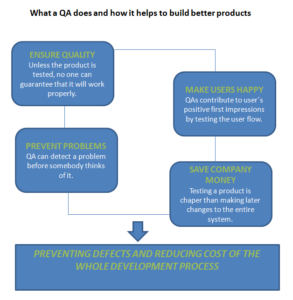Author
Lucas BanderelLucas Banderel works as a quality assurance engineer and as an analyst at Moove It.
Many in the tech industry that does not fulfill the role of QA wonder What do the QAs do? This paragraph will explain some key points that answer that question.
Think back to a time when you wrote a very important document for a college class. You’ve put all the finishing touches on it, and read through it. Everything looks great! Just to be safe, you ask someone in your family or some friend to review your work. He finds some big errors in your document. Not only have you misspelled (multiple) words, but you also put a citation in the wrong place, didn’t space correctly on a quoted paragraph, and changed the verb tense somewhere along the way. “Thank goodness for that second pair of eyes”, you think to yourself.
When you work on something intently for a long span of time, it can be easy to miss things that would otherwise stand out. The same thing can happen during development. This is why it’s important to have a software Quality Assurance (QA) team to back your developers. Not only will Quality Assurance ensure that a website or application works, but the QA team can also find new scenarios where the application could be improved.
A software Quality Assurance has to investigate a product and always be asking “Why?”. A good QA is inquisitive and thinks outside the box, no matter if they are manual or automated tester. A common misconception that many in the tech industry believe is that QA exists just to break or destroy an application. While a developer or programmer’s role is to create, a QA tester’s job is to break down, analyze, find the broken pieces, and provide feedback so the project can be re-created (or improved).
If QAs are not involved in the development process, it may later appear that the development team made something that despite working well, was not what was originally intended. Involving a QA team also helps reduce the time needed to devise new test cases, because the earlier we understand what we’re going to check and how the easier it is to conduct such testing. It’s crucial for the development and QA teams to work together, otherwise, it may turn into a who-can-find-more-bugs fight. This rarely leads to quality results.

A bug found and fixed during the early stages can save a lot of money. When coding, a bug requires very little effort to be fixed, during system testing, it may delay delivery. But here’s the problem: during project release, it may cause catastrophic consequences from a nuisance to a system failure.
That is why Quality Assurance teams are crucial, their goal is to find bugs as early as possible and contribute to the main goals of the project. They are fundamental to the implementation of agile methodologies as it is.
Moreover, the pandemic situation has demanded a new optic on what QA testing means. This new situation we are facing has exposed some needed updates and upgrade on our ways to develop, test, and create a product increment. QA teams are now more essential than ever. Integrating these teams as part of our project estimates is vital for our success.
Now you know, go make friends with your QA team and make sure you keep creating high-quality projects. Also, click here to find out more about Moove It’s QA Studio and our work with our clients.



